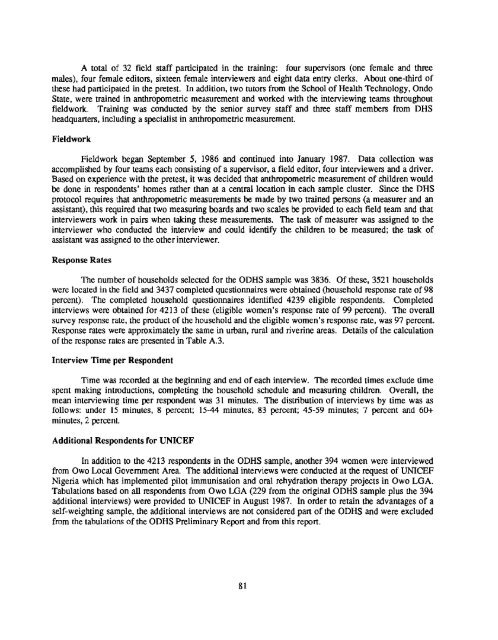Final Report (PDF, 2132K) - Measure DHS
Final Report (PDF, 2132K) - Measure DHS
Final Report (PDF, 2132K) - Measure DHS
Create successful ePaper yourself
Turn your PDF publications into a flip-book with our unique Google optimized e-Paper software.
A total of 32 field staff participated in the training: four supervisors (one female and threemales), four female editors, sixteen female interviewers and eight data entry clerks. About one-third ofthese had participated in the pretest. In addition, two tutors from the School of Health Technology, OndoState, were trained in anthropometric measurement and worked with the interviewing teams throughoutfieldwork. Training was conducted by the senior survey staff and three staff members from <strong>DHS</strong>headquarters, including a specialist in anthropometric measurement.FieldworkFieldwork began September 5, 1986 and continued into January 1987. Data collection wasaccomplished by four teams each consisting of a supervisor, a field editor, four interviewers and a driver.Based on experience with the pretest, it was decided that anthropometric measurement of children wouldbe done in respondents' homes rather than at a central location in each sample cluster. Since the <strong>DHS</strong>protocol requires that anthropometric measurements be made by two trained persons (a measurer and anassistant), this required that two measuring boards and two scales be provided to each field team and thatinterviewers work in pairs when taking these measurements. The task of measurer was assigned to theinterviewer who conducted the interview and could identify the children to be measured; the task ofassistant was assigned to the other interviewer.Response RatesThe number of households selected for the O<strong>DHS</strong> sample was 3836. Of these, 3521 householdswere located in the field and 3437 completed questionnaires were obtained (household response rate of 98percent). The completed household questionnaires identified 4239 eligible respondents. Completedinterviews were obtained for 4213 of these (eligible women's response rate of 99 percent). The overallsurvey response rate, the product of the household and the eligible women's response rate, was 97 percent.Response rates were approximately the same in urban, rural and riverine areas. Details of the calculationof the response rates are presented in Table A.3.Interview Time per RespondentTime was recorded at the beginning and end of each interview. The recorded times exclude timespent making introductions, completing the household schedule and measuring children. Overall, themean interviewing time per respondent was 31 minutes. The distribution of interviews by time was asfollows: under 15 minutes, 8 percent; 15-44 minutes, 83 percent; 45-59 minutes; 7 percent and 60+minutes, 2 percent.Additional Respondents for UNICEFIn addition to the 4213 respondents in the O<strong>DHS</strong> sample, another 394 women were interviewedfrom Owo Local Govemment Area. The additional interviews were conducted at the request of UNICEFNigeria which has implemented pilot immunisation and oral rehydration therapy projects in Own LGA.Tabulations based on all respondents from Owo LGA (229 from the original O<strong>DHS</strong> sample plus the 394additional interviews) were provided to UNICEF in August 1987. In order to retain the advantages of aself-weighting sample, the additional interviews are not considered part of the O<strong>DHS</strong> and were excludedfrom the tabulations of the O<strong>DHS</strong> Preliminary <strong>Report</strong> and from this report.81








![Obtaining Informed Consent for HIV Testing [QRS4] - Measure DHS](https://img.yumpu.com/49850117/1/190x245/obtaining-informed-consent-for-hiv-testing-qrs4-measure-dhs.jpg?quality=85)







